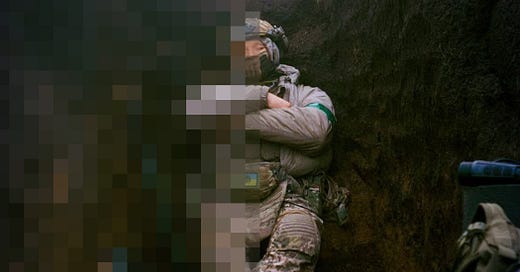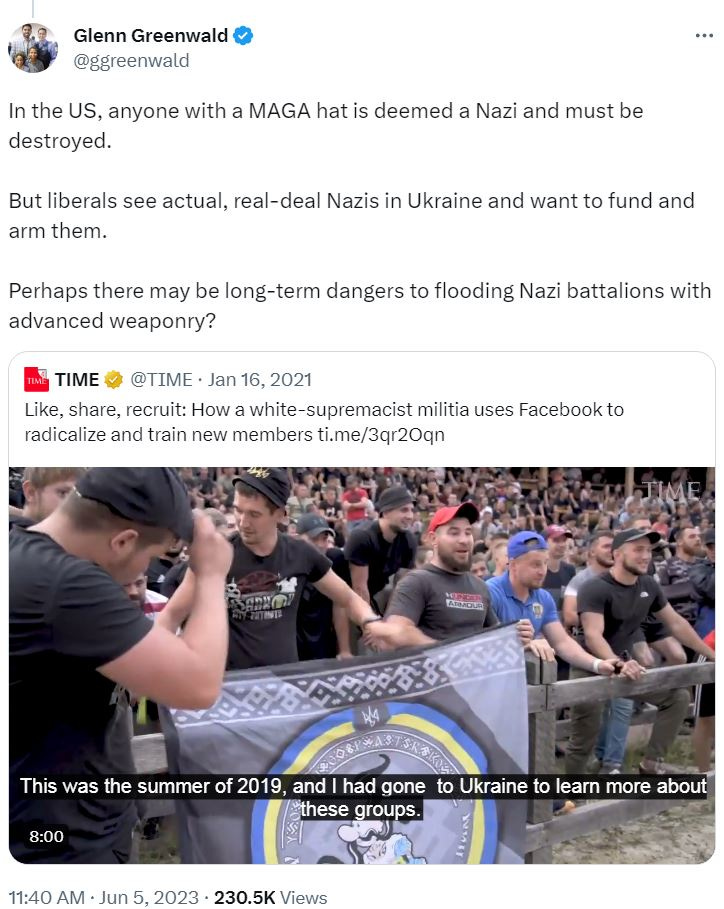

THE KREMLIN TALKING POINT that Ukraine is run by a Nazi junta and that its armed forces are infested with neo-Nazis, periodically recycled by the Ukrainophobic contingent in American punditry, got a boost just before start of the Ukrainian counteroffensive from a New York Times article, “Nazi Symbols on Ukraine’s Front Lines Highlight Thorny Issues of History.” The story, which reports instances of Nazi-associated imagery spotted on some Ukrainian soldiers’ uniforms, and of Ukrainian authorities removing social media posts with such images, discusses the complexities of these symbols in the context of Ukrainian history. It predictably elicited I-told-you-so’s from the usual quarters, and the Times’s attempt at nuance was singled out for particular derision.
Glenn Greenwald weighed in on Twitter:
Laura Ingraham offered her perspective on her Fox News show:
The New York Times is basically saying—well, first, they never had any issue finding white supremacists no matter where they look. Clarence Thomas is one of course, Ted Cruz . . . everyone’s a white supremacist. But when it comes to Ukrainian soldiers and Nazi patches on their uniforms or elsewhere, they have a surprising amount of nuance. “Nazi symbols on Ukraine’s front lines highlight thorny issues of history.” Wait, so Nazism is now a “thorny issue” according to the New York Times? Only the media’s thirst for never-ending funding of Ukraine’s war effort could, I think, move to diminish the crimes of the Nazis. You can’t make this up.
Matt Taibbi found it particularly “disgusting” that some Western journalists had asked Ukrainian soldiers to cover up questionable patches when posing for photos:
Journalists asking soldiers to remove Nazi patches is a new level of insanity. With the line between propagandist and reporter all but dissolved, how long before embeds are offered NATO uniforms?
Breitbart joined in the gloating (“Neo-Nazis in Ukraine Might be a Problem After All, Says New York Times”), pointing out that “until now many Western establishment media outlets, not least amongst them the NYT, have been bullish on calling out people discussing Ukrainian neo-Nazi iconography as spreading ‘false claims.’” The Breitbart piece also waxed sarcastic over the Times invoking “feelings about the Confederate ‘Southern Pride’ flag in the U.S.” as a parallel to the interpretation of controversial images in Ukraine as symbols of national pride.
Leaving aside Breitbart’s clunky prose and Greenwald’s hyperbole (does anyone at the New York Times really advocate that all MAGA hat wearers be “destroyed”?), one could conceivably make a case that the Times is in fact guilty of some double standards: Ukrainian soldiers who wear patches with images they claim to associate with their country’s history and honor are given more benefit of the doubt than American Southerners who make the same claims about displaying the Confederate flag. But one would think that Breitbart and Ingraham—and Greenwald, given the current rightward tilt of his cultural sympathies—would endorse the view that a Stars-and-Bars bumper sticker or baseball cap does not necessarily mark a person as a white supremacist. Instead, they seem to endorse an opposite double standard: Americans attacked for displaying controversial symbols widely linked to hate are victims of left-wing intolerance, but the Ukrainian soldiers wearing such symbols in Ukraine are “real-deal Nazis.” When your side in the culture wars denounces the removal of Confederate monuments or military base names as wokeness gone mad, you’re not exactly in a position to condemn other people who are reluctant to discard symbols of a tarnished heritage.
FAR-RIGHT MOVEMENTS in Ukraine are a real problem. Likewise, the country’s official embrace of World War II-era nationalist groups that sometimes allied themselves with Nazi Germany against Soviet Russia, such as Stepan Bandera’s Organization of Ukrainian Nationalists, raises troubling issues. While the modern Ukrainian mythos of Bandera and the OUN is not pro-Nazi, it is a fictionalized version of history that elides the Nazi collaboration and anti-Jewish violence, instead selectively focusing on Bandera’s imprisonment by the Germans and OUN’s occasional condemnations of antisemitism. The ethics of historical falsification aside, such distortions can become, like the myth of a benign Confederacy in the United States, a gateway for extremism.
But coming to grips honestly with these issues doesn’t change the fact that far-right ideologies have very little political influence in Ukraine right now, or that in the six years preceding the 2022 Russian invasion the Ukrainian military has made a genuine effort to purge extremists from its ranks and curb human rights abuses.
What about those “Nazi symbols,” then? It is worth noting that not one of the instances mentioned by the Times involved the swastika or the SS lightning bolts. (So far at least, the images of Ukrainian soldiers with swastika flags that one sees floating around social media are almost certain fakes.) The real images all involve either the “Sonnenrad” or “Black Sun”—a pagan runic symbol used at times by the Nazi party and the SS, which the Anti-Defamation League notes should not be automatically considered a hate symbol on account of its use in cultures around the world—or the “Totenkopf” or “death’s head,” a cartoonishly stylized skull with crossbones.
The Totenkopf is infamous—it’s even at the center of Mitchell and Webb’s immortal “Are we the baddies?” 2006 sketch—and its use is certainly disturbing. The ADL notes that, unlike other skull-and-crossbones emblems, the specific Totenkopf design used by various Nazi units (and spotted in several photos of Ukrainian soldiers) is indeed a hate symbol. Nonetheless, ADL spokesman Jack Hyman told the Times that it was impossible to “make an inference about the wearer or the Ukrainian Army” solely on the basis of such a patch.
Let’s unpack Hyman’s point. It’s true that the soldier wearing the patch may be intentionally wearing a hate symbol (which certainly deserves condemnation); but he or she may also be ignorant of the symbol’s Nazi use, or may not understand the specificity of the Nazi Totenkopf compared to different skull images used in military logos and patches in a number of countries (including the United States). The soldier may simply think it’s a badass emblem of deadliness in battle. Without knowing anything else about the Ukrainian press officer who told the Times reporter he didn’t think of his Totenkopf patch as a Nazi image, we cannot know if he was being sincere or dishonest—or at very least cavalier about the emblem’s historical meaning.
We also don’t know how widespread the Nazi-style symbols are. Over the past sixteen months, literally thousands of Ukrainian soldiers have been photographed and filmed, usually in settings where it’s extremely unlikely that they could have been directed to remove offensive symbols; yet confirmed “Nazi imagery” sightings are quite rare. Meanwhile, numerous Ukrainian Jews—and some Ukrainian-born Israeli Jews who have returned to help their former homeland in a time of need—are currently fighting in the Ukrainian armed forces, which recently got their first Jewish chaplain. One such soldier, a middle-aged professor who volunteered to fight, told the Forward that the only antisemitism he ever experienced in the military was when serving in the Soviet army as a young man.
Should the Ukrainian military do more to proactively curb genuine extremism in the ranks and educate soldiers about unintentional use of hate symbols? In better world, the obvious answer would be yes. In the world as it is, it’s understandable that they have other priorities right now. In the meantime, the Times article’s nuance seems entirely appropriate.
THE TIMES PIECE INCLUDES another interesting detail, one that seemed completely to elude Team I-Told-You-So:
Russian soldiers in Ukraine have also been seen wearing Nazi-style patches, underscoring how complicated interpreting these symbols can be in a region steeped in Soviet and German history.
The symbols worn by the Russian soldier in the linked story are the Totenkopf and an old Norse image known as the valknot, which the ADL confirms is not always racist depending on context. But if it’s sauce for the goose, it’s certainly sauce for the gander.
One might also take a look at the imagery of the Wagner mercenary group, which has a Totenkopf-like skull in one of its logos and whose main logo, with the words “Blood, Honor, Motherland, Courage,” has a strong Nazi-aesthetic feel about it. (Wagner mercenaries are also reportedly known to spray-paint swastikas and SS lightning bolts.) Or one could broaden this discussion to the way so much official Russian rhetoric today evokes Hitlerian tropes, from the obsession with reclaiming supposed ancestral lands to the cult of hypermasculinity.
But the question of Nazi (or supposedly Nazi) symbolism in Ukraine should also raise another issue: the Russian invaders’ push to revive the legacy of the twentieth century’s other brand of murderous totalitarianism, namely Soviet communism. In some areas such as Melitopol, the Russian occupation has brought back statues of Vladimir Lenin, previously taken down as part of Ukraine’s “de-communization” drive since 2015. Joseph Stalin has appeared on billboards and banners in annexed Crimea and in the Russia-controlled enclaves in Eastern Ukraine; one of those enclaves, Donetsk, was even temporarily renamed Stalino, its Stalin-era name, for the May 2020 Victory Day celebrations. Meanwhile, Russia’s official Soviet name for Bakhmut—Artyomovsk—is a tribute to the Bolshevik revolutionary “Comrade Artyom” (real name Fyodor Sergeyev), who had such a close friendship with Stalin that the dictator adopted his son after Sergeyev died in a railway accident in 1921. His career included heading a mission by the Cheka, the first Soviet secret police, to crush a peasant rebellion against grain requisitions.
The leftists who flog the “Ukrainian Nazis” theme (such as onetime Nation contributor Patrick Lawrence) no doubt believe it’s utterly scandalous to compare Soviet and Nazi symbolism. But what do Fox News or Breitbart have to say?

















